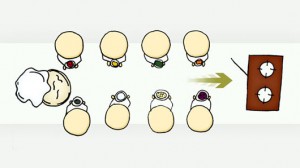Regular discipline – 40 hours – post-graduate program in Interaction Design – Faber-Ludens Interaction Design Institute.
The goal of this course is to engage students into deep reflection about the possibilities of Interaction Design. The biggest challenge is to make them perceive that Interaction Design is not tied to any particular technology. It does what it says: it is a design field that works to define people’s interaction. In some cases, the interaction will need the mediation of technology, but, in others, no technology is necessary. The main concern is people social behavior, driven much more by cultural factors than specific technology features.
The first assignment is to design a Nintendo Wii critical game that proposes a reflection about urban violence. Videogames are used to reflect on videogames, a meta-media exercise. Nintendo Wii platform was chosen because it enable users to express their emotions through their own body, making game actions much more visible to social judgements.
At Andressão game, the player is a ladyboy prostitute that must attract customers and defend her space in order to survive in a big city. Other games can be seen at the Critical Games project page.
The second assignment is to investigate how a product shapes user perception of reality and change some of it´s feature to see what happens. The Hacking Reality brief makes them interview users and use lowtech solutions in a experimental way. One student redesigned the conventional scrapbook to a digital version.
The final assignment was a direct experiment with the abstract notion of Interaction. Students had to analyze an activity using the Engeström System, find some contradictions and try to change the activity introducing new rules for interaction. The rules had to come from a children game that is on our database, transforming boring tasks into funny ones.

One of the students analyzed how his friend prepared pizza in a party. There were contradictions between the taste of his friend and the group of invitees, so the pizaiollo were isolated from the group for the most of the time. The student proposed a children game to make the pizza collaboratively: each invitee will take an ingredient and the pizzaiolo will pass through them, aggregating the contributions to the pizza. There were no high technology involved in this project, but it was clear that they were designing interactions.


